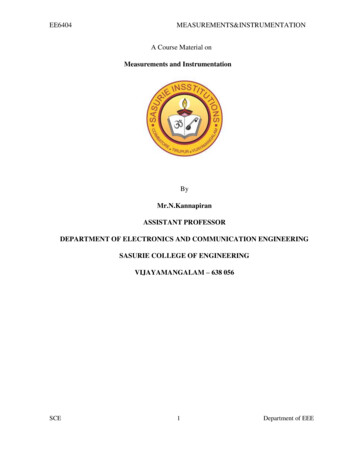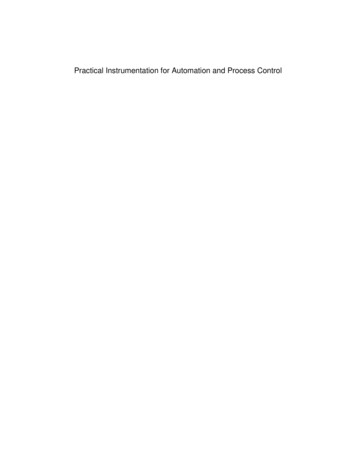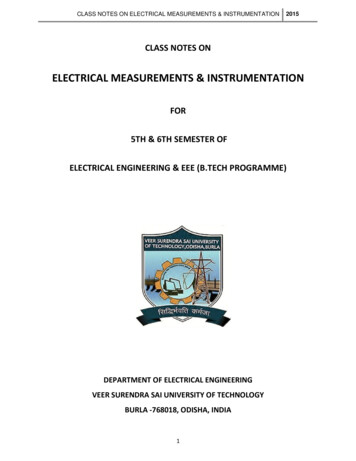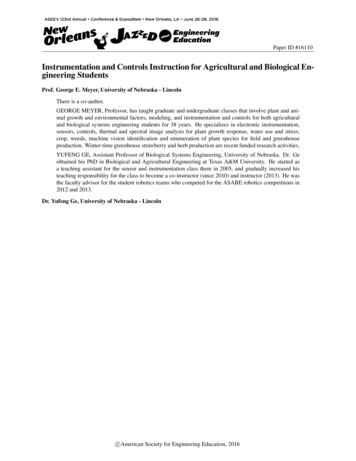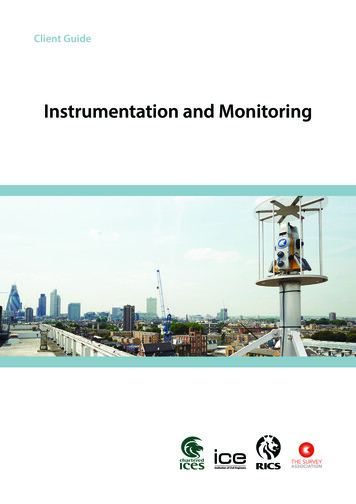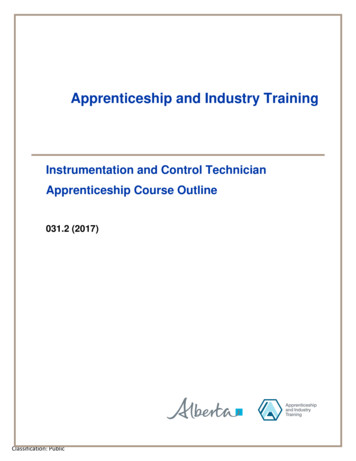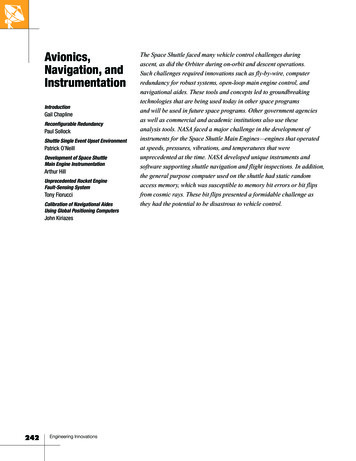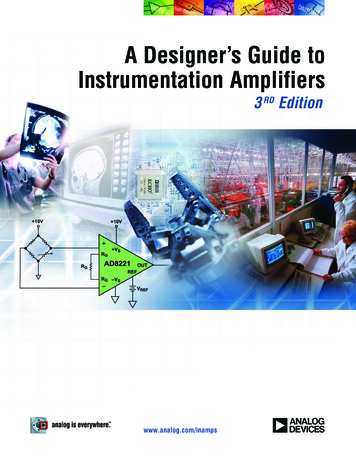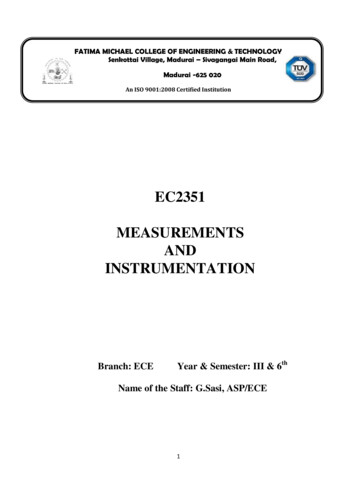
Transcription
FATIMA MICHAEL COLLEGE OF ENGINEERING & TECHNOLOGYSenkottai Village, Madurai – Sivagangai Main Road,Madurai -625 020An ISO 9001:2008 Certified nch: ECEYear & Semester: III & 6thName of the Staff: G.Sasi, ASP/ECE1
SyllabusEC2351 MEASUREMENTS AND INSTRUMENTATIONLTPC3 0 0 3UNIT I BASIC MEASUREMENT CONCEPTS9Measurement systems – Static and dynamic characteristics – units and standards ofmeasurements – error :- accuracy and precision, types, statistical analysis – moving coil,moving iron meters – multimeters – Bridge measurements : – Maxwell, Hay, Schering,Anderson and Wien bridge.UNIT II BASIC ELECTRONIC MEASUREMENTS9Electronic multimeters – Cathode ray oscilloscopes – block schematic – applications –special oscilloscopes :– delayed time base oscilloscopes, analog and digital storageoscilloscope, sampling oscilloscope – Q meters – Vector meters – RF voltage andpower measurements – True RMS meters.UNIT III SIGNAL GENERATORS AND ANALYZERS9Function generators – pulse and square wave generators, RF signal generators –Sweep generators – Frequency synthesizer – wave analyzer – Harmonic distortionanalyzer – spectrum analyzer :- digital spectrum analyzer, Vector Network Analyzer –Digital L,C,R measurements, Digital RLC meters.UNIT IV DIGITAL INSTRUMENTS9Comparison of analog and digital techniques – digital voltmeter – multimeters –frequency counters – measurement of frequency and time interval – extension offrequency range – Automation in digital instruments, Automatic polarity indication,automatic ranging, automatic zeroing, fully automatic digital instruments, Computercontrolled test systems, Virtual instruments.UNIT V DATA ACQUISITION SYSTEMS AND FIBER OPTIC MEASUREMENT 9Elements of a digital data acquisition system – interfacing of transducers – multiplexing –data loggers –computer controlled instrumentation – IEEE 488 bus – fiber opticmeasurements for power and system loss – optical time domains reflectometer.TOTAL: 45 PERIODSTEXT BOOKS1. Albert D.Helfrick and William D.Cooper – Modern Electronic Instrumentation andMeasurement Techniques, Pearson / Prentice Hall of India, 2007.2. Ernest O. Doebelin, Measurement Systems- Application and Design, TMH, 2007.REFERENCES1. Joseph J.Carr, Elements of Electronics Instrumentation and Measurement, PearsonEducation, 2003.2. Alan. S. Morris, Principles of Measurements and Instrumentation, 2nd Edition,Prentice Hall of India, 2003.3. David A. Bell, Electronic Instrumentation and measurements, Prentice Hall of IndiaPvt Ltd, 2003.4. B.C. Nakra and K.K. Choudhry, Instrumentation, Meaurement and Analysis, 2ndEdition, TMH, 2004.5. James W. Dally, William F. Riley, Kenneth G. McConnell, Instrumentation forEngineering Measurements, 2nd Edition, John Wiley, 2003.2
UNIT I - BASIC MEASUREMENT CONCEPTS:Functional elements of Instruments Primary sensing element Variable conversion element Data presentation elementPrimary sensing elementThe quantity under measurement makes its first contact with primarysensing element of a measurement systemhere, the primary sensing elementtransducer. This transducer converts measured into an analogous electrical signal.Variable conversion elementThe output of the primary sensing element is the electrical signal. It may be avoltage a frequency or some other electrical parameter. But this output is not suitable forthis system.For the instrument to perform the desired function, it may be necessary toconvert this output to some other suitable form while retaining the original signal.Consider an example, suppose output is an analog signal form and the next of systemaccepts input signal only in digital form . Therefore we have to use and to digitalconverter in this system.Variable manipulation elementThe main function of variable manipulation element is to manipulation elementis to manipulate the signal presented to it preserving the original nature of the signal.Here, manipulation means a change in numerical value of the signal.3
Consider a small example, an electric amplifier circuit accepts a small voltagesignal as input and produces an output signal which is also voltage but of greateramplifier. Thus voltage amplifier acts as a variable manipulation element.Data presentation elementThe information about the quantity under measurement has to be conveyed tothe personal handling the instrument or system for control or analysis purposes. Theinformation conveyed must be in the form of intelligible to the personnel. The abovefunction is done by data presentation element.The output or data of the system can be monitored by using visual displaydevices may be analog or digital device like ammeter, digital meter etc. In case thedata to be record, we can use analog or digital recording equipment. In industries , forcontrol and analysis purpose we can use computers.The final stage in a measurement system is known as terminating stage . whena control device is used for the final measurement stage it is necessary to apply somefeedback to the input signal to accomplish the control 0bjective.The term signal conditioning includes many other functions in addition tovariable conversion and variable manipulation. In fact the element that follows theprimary sensing element in any instrument or instrumentation system should be calledsignal conditioning element.When the element of an instrument is physically separated, it becomes necessaryto transmit data from one to another. This element is called transmitting element. Thesignal conditioning and transmitting stage is generally known as intermediate stage.4
Measurement system:Measurement system any of the systems used in the process of associating numbers withphysical quantities and phenomena. Although the concept of weights and measures todayincludes such factors as temperature, luminosity, pressure, and electric current, it onceconsisted of only four basic measurements: mass (weight), distance or length, area, andvolume (liquid or grain measure). The last three are, of course, closely related. Basic tothe whole idea of weights and measures are the concepts of uniformity, units, andstandards.Uniformity, the essence of any system of weights and measures, requiresaccurate, reliable standards of mass and length .Static Characteristics of Instrument Systems:Output/Input RelationshipInstrument systems are usually built up from a serial linkage of distinguishable buildingblocks. The actual physical assembly may not appear to be so but it can be broken down intoa representative diagram of connected blocks. In the Humidity sensor it is activated by aninput physical parameter and provides an output signal to the next block that processes thesignal into a more appropriate state.A key generic entity is, therefore, the relationship between the input and output of theblock. As was pointed out earlier, all signals have a time characteristic, so we must considerthe behavior of a block in terms of both the static and dynamic states.The behavior of the static regime alone and the combined static and dynamic regime canbe found through use of an appropriate mathematical model of each block. Themathematical description of system responses is easy to set up and use if the elements all actas linear systems and where addition of signals can be carried out in a linear additivemanner. If nonlinearity exists in elements, then it becomes considerably more difficult —perhaps even quite impractical — to provide an easy to follow mathemat- ical explanation.Fortunately, general description of instrument systems responses can be usually beadequately covered using the linear treatment.The output/input ratio of the whole cascaded chain of blocks 1, 2, 3, etc. is given as:[output/input]total [output/input]1 [output/input]2 [output/input]3 5
The output/input ratio of a block that includes both the static and dynamic characteristics iscalled the transfer function and is given the symbol G.The equation forG can be written as two parts multiplied together. One expresses thestatic behavior of the block, that is, the value it has after all transient (time varying) effectshave settled to their final state. The other part tells us how that value responds when the block is in itsdynamic state. The static part is known as the transfer characteristic and isoften all that is needed to be known for block description.The static and dynamic response of the cascade of blocks is simply the multiplication ofall individual blocks. As each block has its own part for the static and dynamic behavior, thecascade equations can be rearranged to separate the static from the dynamic parts and thenby multiplying the static set and the dynamic set we get the overall response in the static anddynamic states. This is shown by the sequence of Equations.Instruments are formed from a connection of blocks. Each block can be represented by aconceptual and mathematical model. This example is of one type of humidity sensor.6
Drift :It is now necessary to consider a major problem of instrument performance calledinstrument drift . This is caused by variations taking place in the parts of the instrumentationover time. Prime sources occur as chemical structural changes and changing mechanicalstresses. Drift is a complex phenomenon for which the observed effects are that thesensitivity and offset values vary. It also can alter the accuracy of the instrument differentlyat the various amplitudes of the signal present.Detailed description of drift is not at all easy but it is possible to work satisfactorily withsimplified values that give the average of a set of observations, this usually being quoted in aconservative manner. The first graph (a) in Figure shows typical steady drift of a measuringspring component of a weighing balance. Figure (b) shows how an electronic amplifier mightsettle down after being turned on.Drift is also caused by variations in environmental parameters such as temperature,pressure, and humidity that operate on the components. These are known as influenceparameters. An example is the change of the resistance of an electrical resistor, this resistorforming the critical part of an electronic amplifier that sets its gain as its operating7
temperature changes.Unfortunately, the observed effects of influence parameter induced drift often are the same as fortime varying drift. Appropriate testing of blocks such as electronic amplifiers does allow the twoto be separated to some extent. For example, altering only the temperature of theamplifier over a short period will quickly show its temperature dependence.Drift due to influence parameters is graphed in much the same way as for time drift. Figureshows the drift of an amplifier as temperature varies. Note that it depends significantly on thetemperatureDrift in the performance of an instrument takes many forms:(a ) drift over time for a spring balance;( b ) how an electronic amplifier might settle over time to a final value after power issupplied;(c ) drift, due to temperature, of an electronic amplifier varies with the actual temperature ofoperation.Dynamic Characteristics of Instrument Systems:Dealing with Dynamic States:Measurement outcomes are rarely static over time. They will possess a dynamic componentthat must be understood for correct interpretation of the results. For example, a trace madeon an ink pen chart recorder will be subject to the speed at which the pen can follow theinput signal changes.Drift in the performance of an instrument takes many forms: (a ) driftover time for a spring8
Error of nonlinearity can be expressed in four different ways: (a) best fit line (based onselected method used to decide this); (b) best fit line through zero; (c) line joining 0% and 100%points; and (d) theoretical lineTo properly appreciate instrumentation design and its use, it is now necessary to developinsight into the most commonly encountered types of dynamic response and to develop the9
mathematical modeling basis that allows us to make concise statements about responses.If the transfer relationship for a block follows linear laws of performance, then a genericmathematical method of dynamic description can be used. Unfortunately, simplemathematical methods have not been found that can describe all types of instrumentresponses in a simplistic and uniform manner. If the behavior is nonlinear, then descriptionwith mathematical models becomes very difficult and might be impracticable. The behavior of nonlinearsystems can, however, be studied as segments of linear behavior joined end to end. Here,digital computers are effectively used to model systems of any kind provided the user isprepared to spend time setting up an adequate model.Now the mathematics used to describe linear dynamic systems can be introduced. Thisgives valuable insight into the expected behavior of instrumentation, and it is usually foundthat the response can be approximated as linear.The modeled response at the output of a blockGresult is obtained by multiplying themathematical expression for the input signalGinput by the transfer function of the blockunder investigationGresponse, as shown in below equationGresult Ginput GresponseTo proceed, one needs to understand commonly encountered input functions and the varioustypes of block characteristics. We begin with the former set: the so-called forcing functions.Forcing FunctionsLet us first develop an understanding of the various types of input signal used to performtests. The most commonly used signals are shown in Figure 3.12. These each possessdifferent valuable test features. For example, the sine-wave is the basis of analysis of allcomplex wave-shapes because they can be formed as a combination of various sinewaves, each having individual responses that add to give all other wave- shapes. The stepfunction has intuitively obvious uses because input transients of this kind are commonlyencountered. The ramp test function is used to present a more realistic input for thosesystems where it is not possible to obtain instantaneous step input changes, such asattempting to move a large mass by a limited size of force. Forcing functions are also chosenbecause they can be easily described by a simple mathematical expression, thus makingmathematical analysis relatively straightforward.10
Characteristic Equation DevelopmentThe behavior of a block that exhibits linear behavior is mathematically represented in thegeneral form of expression given as EquationHere, the coefficientsa2,a1, anda0 are constants dependent on the particular block of interest. The lefthand side of the equation is known as the characteristic equation. It is specific to the internalproperties of the block and is not altered by the way the block is used.The specific combination of forcing function input and block characteristic equation collectivelydecides the combined output response. Connections around the block, such as feedbackfrom the output to the input, can alter the overall behavior significantly: such systems, however, arenot dealt with in this section being in the domain of feedback control systems.11
Unit of measurement:A unit of measurement is a definite magnitude of a physical quantity, defined andadopted by convention and/or by law, that is used as a standard for measurement of thesame physical quantity.[1] Any other value of the physical quantity can be expressed as asimple multiple of the unit of measurement.For example, length is a physical quantity. Themetre is a unit of length that represents a definite predetermined length. When we say 10metres (or 10 m), we actually mean 10 times the definite predetermined length called"metre".The definition, agreement, and practical use of units of measurement have played a12
crucial role in human endeavour from early ages up to this day. Disparate systems of unitsused to be very common. Now there is a global standard, the International System of Units(SI), the modern form of the metric system.In trade, weights and measures is often a subjectof governmental regulation, to ensure fairness and transparency. The Bureau internationaldes poids et mesures (BIPM) is tasked with ensuring worldwide uniformity ofmeasurements and their traceability to the International System of Units (SI). Metrology isthe science for developing nationally and internationally accepted units of weights andmeasures.In physics and metrology, units are standards for measurement of physicalquantities that need clear definitions to be useful. Reproducibility of experimental results iscentral to the scientific method. A standard system of units facilitates this. Scientificsystems of units are a refinement of the concept of weights and measures developed longago for commercial purposes.Science, medicine, and engineering often use larger andsmaller units of measurement than those used in everyday life and indicate them moreprecisely. The judicious selection of the units of measurement can aid researchers inproblem solving (see, for example, dimensional analysis).In the social sciences, there are nostandard units of measurement and the theory and practice of measurement is studied inpsychometrics and the theory of conjoint measurement.Error Analysis :IntroductionThe knowledge we have of the physical world is obtained by doing experiments andmaking measurements. It is important to understand how to express such data and how toanalyze and draw meaningful conclusions from it.In doing this it is crucial to understandthat all measurements of physical quantities are subject to uncertainties. It is never possibleto measure anything exactly. It is good, of course, to make the error as small as possible butit is always there. And in order to draw valid conclusions the error must be indicated anddealt with properly.Take the measurement of a person's height as an example. Assumingthat her height has been determined to be 5' 8", how accurate is our result?Well, the heightof a person depends on how straight she stands, whether she just got up (most people areslightly taller when getting up from a long rest in horizontal position), whether she has hershoes on, and how long her hair is and how it is made up. These inaccuracies could all becalled errors of definition. A quantity such as height is not exactly defined withoutspecifying many other circumstances.Even if you could precisely specify the13
"circumstances," your result would still have an error associated with it. The scale you areusing is of limited accuracy; when you read the scale, you may have to estimate a fractionbetween the marks on the scale, etc.If the result of a measurement is to have meaning it cannot consist of the measured valuealone. An indication of how accurate the result is must be included also. Indeed, typicallymore effort is required to determine the error or uncertainty in a measurement than toperform the measurement itself. Thus, the result of any physical measurement has twoessential components: (1) A numerical value (in a specified system of units) giving the bestestimate possible of the quantity measured, and (2) the degree of uncertainty associatedwith this estimated value. For example, a measurement of the width of a table would yield aresult such as 95.3 /- 0.1 cm.Significant Figures :The significant figures of a (measured or calculated) quantity are the meaningful digits init. There are conventions which you should learn and follow for how to express numbers soas to properly indicate their significant figures.Any digit that is not zero is significant. Thus 549 has three significant figures and1.892 has four significant figures.Zeros between non zero digits are significant. Thus 4023 has four significant figures.Zeros to the left of the first non zero digit are not significant. Thus 0.000034 hasonly two significant figures. This is more easily seen if it is written as 3.4x10-5.For numbers with decimal points, zeros to the right of a non zero digit aresignificant. Thus 2.00 has three significant figures and 0.050 has two significantfigures. For this reason it is important to keep the trailing zeros to indicate theactual number of significant figures.For numbers without decimal points, trailing zeros may or may not be significant.Thus, 400 indicates only one significant figure. To indicate that the trailing zerosare significant a decimal point must be added. For example, 400. has threesignificant figures, andhas one significant figure.Exact numbers have an infinite number of significant digits. For example, if thereare two oranges on a table, then the number of oranges is 2.000. . Defined numbers14
are also like this. For example, the number of centimeters per inch (2.54) has aninfinite number of significant digits, as does the speed of light (299792458 m/s).There are also specific rules for how to consistently express the uncertainty associatedwith a number. In general, the last significant figure in any result should be of the sameorder of magnitude (i.e. in the same decimal position) as the uncertainty. Also, theuncertainty should be rounded to one or two significant figures. Always work out theuncertainty after finding the number of significant figures for the actual measurement.For example,9.82 /- 0.0210.0 /- 1.54 /- 1The following numbers are all incorrect.9.82 /- 0.02385 is wrong but 9.82 /- 0.02 is fine10.0 /- 2 is wrong but 10.0 /- 2.0 is fine4 /- 0.5 is wrong but 4.0 /- 0.5 is fineIn practice, when doing mathematical calculations, it is a good idea to keep one more digitthan is significant to reduce rounding errors. But in the end, the answer must be expressedwith only the proper number of significant figures. After addition or subtraction, the resultis significant only to the place determined by the largest last significant place in the originalnumbers. For example,89.332 1.1 90.432should be rounded to get 90.4 (the tenths place is the last significant place in 1.1). Aftermultiplication or division, the number of significant figures in the result is determined bythe original number with the smallest number of significant figures. For example,(2.80) (4.5039) 12.61092should be rounded off to 12.6 (three significant figures like 2.80).Refer to any good introductory chemistry textbook for an explanation of themethodology for working out significant figures.15
The Idea of Error :The concept of error needs to be well understood. What is and what is not meant by"error"? A measurement may be made of a quantity which has an accepted value which canbe looked up in a handbook (e.g. the density of brass). The difference between themeasurement and the accepted value is not what is meant by error. Such accepted valuesare not "right" answers. They are just measurements made by other people which haveerrors associated with them as well. Nor does error mean "blunder." Reading a scalebackwards, misunderstanding what you are doing or elbowing your lab partner's measuringapparatus are blunders which can be caught and should simply be disregarded. Obviously, itcannot be determined exactly how far off a measurement is; if this could be done, it wouldbe possible to just give a more accurate, corrected value. Error, then, has to do withuncertainty in measurements that nothing can be done about. If a measurement is repeated,the values obtained will differ and none of the results can be preferred over the others.Although it is not possible to do anything about such error, it can be characterized. Forinstance, the repeated measurements may cluster tightly together or they may spreadwidely. This pattern can be analyzed systematically.Classification of Error :Generally, errors can be divided into two broad and rough but useful classes: systematicand random.Systematic errors are errors which tend to shift all measurements in asystematic way so their mean value is displaced. This may be due to such things asincorrect calibration of equipment, consistently improper use of equipment or failure toproperly account for some effect. In a sense, a systematic error is rather like a blunder andlarge systematic errors can and must be eliminated in a good experiment. But smallsystematic errors will always be present. For instance, no instrument can ever be calibratedperfectly.Other sources of systematic errors are external effects which can change theresults of the experiment, but for which the corrections are not well known. In science, thereasons why several independent confirmations of experimental results are often required(especially using different techniques) is because different apparatus at different places maybe affected by different systematic effects. Aside from making mistakes (such as thinkingone is using the x10 scale, and actually using the x100 scale), the reason why experimentssometimes yield results which may be far outside the quoted errors is because of systematiceffects which were not accounted for.16
Random errors are errors which fluctuate from one measurement to the next. They yieldresults distributed about some mean value. They can occur for a variety of reasons.They may occur due to lack of sensitivity. For a sufficiently a small change aninstrument may not be able to respond to it or to indicate it or the observer may notbe able to discern it.They may occur due to noise. There may be extraneous disturbances whichcannot be taken into account.They may be due to imprecise definition.They may also occur due to statistical processes such as the roll of dice.Random errors displace measurements in an arbitrary direction whereas systematic errorsdisplace measurements in a single direction. Some systematic error can be substantiallyeliminated (or properly taken into account). Random errors are unavoidable and must belived with. Many times you will find results quoted with two errors. The first errorquoted is usually the random error, and the second is called the systematic error. If onlyone error is quoted, then the errors from all sources are added together. (In quadrature asdescribed in the section on propagation of errors.)A good example of "random error" isthe statistical error associated with sampling or counting. For example, considerradioactive decay which occurs randomly at a some (average) rate. If a sample has, onaverage, 1000 radioactive decays per second then the expected number of decays in 5seconds would be 5000. A particular measurement in a 5 second interval will, of course,vary from this average but it will generally yield a value within 5000 /- . Behavior likethis, where the error,, (1)is called a Poisson statistical process. Typically if one does not knowthat,, in order to estimate this error.A. Mean ValueSuppose an experiment were repeated many, say N, times to get,,17it is assumed
N measurements of the same quantity, x. If the errors were random then the errors in theseresults would differ in sign and magnitude. So if the average or mean value of ourmeasurements were calculated,, (2)some of the random variations could be expected to cancel out with others in the sum. Thisis the best that can be done to deal with random errors: repeat the measurement many times,varying as many "irrelevant" parameters as possible and use the average as the bestestimate of the true value of x. (It should be pointed out that this estimate for a given N willdiffer from the limit as the true mean value; though, of course, for larger N it will be closerto the limit.) In the case of the previous example: measure the height at different times ofday, using different scales, different helpers to read the scale, etc.Doing this should give aresult with less error than any of the individual measurements. But it is obviouslyexpensive, time consuming and tedious. So, eventually one must compromise and decidethat the job is done. Nevertheless, repeating the experiment is the only way to gainconfidence in and knowledge of its accuracy. In the process an estimate of the deviation ofthe measurements from the mean value can be obtained.B. Measuring ErrorThere are several different ways the distribution of the measured values of arepeated experiment such as discussed above can be specified.Maximum ErrorThe maximum and minimum values of the data set,and, could bespecified. In these terms, the quantity,, (3)is the maximum error. And virtually no measurements should ever fall outside.18
Probable ErrorThe probable error,the measured values., specifies the rangewhich contains 50% ofAverage DeviationThe average deviation is the average of the deviations from the mean,. (4)For a Gaussian distribution of the data, about 58% will lie within.Standard DeviationFor the data to have a Gaussian distribution means that the probability ofobtaining the result x is,, (5)whereis most probable value and, which is called the standard deviation,determines the width of the distribution. Because of the law of large numbers thisassumption will tend to be valid for random errors. And so it is common practice toquote error in terms of the standard deviation of a Gaussian distribution fit to theobserved data distribution. This is the way you should quote error in your reports.It is just as wrong to indicate an error which is too large as one which is too small. In themeasurement of the height of a person, we would reasonably expect the error to be /-1/4" ifa careful job was done, and maybe /-3/4" if we did a hurried sample measurement.Certainly saying that a person's height is 5' 8.250" /-0.002" is ridiculous (a single jump willcompress your spine more than this) but saying that a person's height is 5' 8" /- 6" impliesthat we have, at best, made a very rough estimate!C. Standard DeviationThe mean is the most probable value of a Gaussian distribution. In terms of the mean, thestandard deviation of any distribution is,. (6)19
The quantity , the square of the standard deviation, is called the variance. The bestestimate of the true standard deviation is,. (7)The reason why we divide by N to get the
Alan. S. Morris, Principles of Measurements and Instrumentation, 2nd Edition, Prentice Hall of India, 2003. 3. David A. Bell, Electronic Instrumentation and measurements, Prentice Hall of India . as linear systems and where addition of signals can be carried out in a linear additive manner. If nonlinearity exists in elements, then it becomes .
